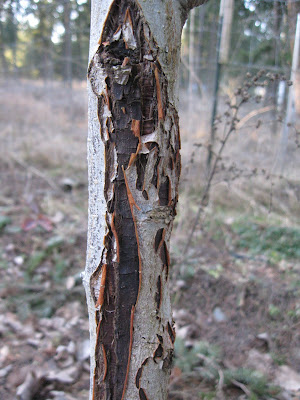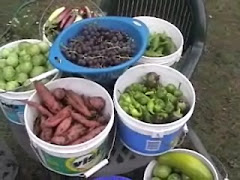 With the days slowly getting longer the sun is finally able to climb above the wall of trees that surround our gardens and shine down upon our greenhouse warming it up inside, 81° today...a regular hothouse. As we have little room and even less patience for seedlings in the house I am trying to get them moved into the greenhouse a tad earlier this year. I moved some of our potted plants and all of our onions and leeks that have germinated thus far into the greenhouse to make room for recently seeded tomatoes, eggplants, and peppers...and so our gardening season begins.
With the days slowly getting longer the sun is finally able to climb above the wall of trees that surround our gardens and shine down upon our greenhouse warming it up inside, 81° today...a regular hothouse. As we have little room and even less patience for seedlings in the house I am trying to get them moved into the greenhouse a tad earlier this year. I moved some of our potted plants and all of our onions and leeks that have germinated thus far into the greenhouse to make room for recently seeded tomatoes, eggplants, and peppers...and so our gardening season begins.The onions, leeks, and scallions can handle a bit of cold weather after a few days of acclimation. As a matter of fact, the soil in their containers has partially frozen a couple times now during the night with no obvious side effects. We made the decision to make do with last year's leftover onion seed, due to a backorder on this year's seed that was slow to arrive, and seem to be having excellent germination with the Yellow of Parma and Jaune Paille des Vertus storage onions but our Borettana seed has not performed as well, perhaps a bit of patience is in order. I also planted a couple flats of Red Globe, Sweet Utah, Candy, and some scallions that are doing splendidly. As soon as our celery and celeriac have finished germinating they will also be booted into the cold to shiver with the alliums.
 These former denizens of our basement dungeon are more than happy to brave the cold as fresh air and sunlight is what they really crave. The Swiss chard, sorrel, endive, and parsley are starting to green up a bit.
These former denizens of our basement dungeon are more than happy to brave the cold as fresh air and sunlight is what they really crave. The Swiss chard, sorrel, endive, and parsley are starting to green up a bit. The first dandelions will be those that were held over from last summer, I have yet to see any outdoors but soon they will begin to appear.
The first dandelions will be those that were held over from last summer, I have yet to see any outdoors but soon they will begin to appear. Rhubarb coming up in a pot...I'm really not sure why, just because I wanted to see how it would do I suppose.
Rhubarb coming up in a pot...I'm really not sure why, just because I wanted to see how it would do I suppose. The last of our celery is starting to put out new growth as well.
The last of our celery is starting to put out new growth as well.

 Last summer's heat was a bit challenging for a few of our smaller fruit trees, most being only 4-7 years old. Towards the end of the gardening season I noticed that two of our apricots and a pear tree had developed some pretty ghastly wounds in the form of bark that had split wide open in numerous places along both the trunk and limbs of the trees. This, having never happened before, was definitely a cause of concern for us and prompted me to dig up some information online that suggested perhaps the trees had suffered from sunscald...dang.
Last summer's heat was a bit challenging for a few of our smaller fruit trees, most being only 4-7 years old. Towards the end of the gardening season I noticed that two of our apricots and a pear tree had developed some pretty ghastly wounds in the form of bark that had split wide open in numerous places along both the trunk and limbs of the trees. This, having never happened before, was definitely a cause of concern for us and prompted me to dig up some information online that suggested perhaps the trees had suffered from sunscald...dang.
 Apparently sunscald is fairly common among younger thin-skinned fruit trees. Fortunately, it is often not fatal to the tree and I was very happy to see lots of new buds had developed on ours this winter signaling that the trees were still full of life. So from what I have been reading I will need to perform
Apparently sunscald is fairly common among younger thin-skinned fruit trees. Fortunately, it is often not fatal to the tree and I was very happy to see lots of new buds had developed on ours this winter signaling that the trees were still full of life. So from what I have been reading I will need to perform 

 "Good job, that's right, just dump the old straw on the ground. Hustle up now I've got eggs to lay."
"Good job, that's right, just dump the old straw on the ground. Hustle up now I've got eggs to lay."



 With no snow to speak of and the ground even starting to thaw a bit I have been out and about hunting for the right soil medium in which to start my onion, leek, celery, and celeriac seedlings. Normally we try to make our own "homemade" potting soil that does differ slightly each year depending upon what type of materials we can come up with. For the most part I just try to produce a semi-fine soil that is able to retain moisture and remain pliable without hardening up. Our house is heated with a wood stove and the one drawback of this is the lack of humidity in the air, this lack of moisture tends to cause the soil in our seedling trays to harden very quickly making it difficult for the plants to germinate and grow. So when it comes to potting soil my focus is on keeping the dirt soft and arable.
With no snow to speak of and the ground even starting to thaw a bit I have been out and about hunting for the right soil medium in which to start my onion, leek, celery, and celeriac seedlings. Normally we try to make our own "homemade" potting soil that does differ slightly each year depending upon what type of materials we can come up with. For the most part I just try to produce a semi-fine soil that is able to retain moisture and remain pliable without hardening up. Our house is heated with a wood stove and the one drawback of this is the lack of humidity in the air, this lack of moisture tends to cause the soil in our seedling trays to harden very quickly making it difficult for the plants to germinate and grow. So when it comes to potting soil my focus is on keeping the dirt soft and arable.


 A wheelbarrow full of ant nest, we have lots of these nests around but only a couple that were abandoned.
A wheelbarrow full of ant nest, we have lots of these nests around but only a couple that were abandoned.


 Rowdy, diligently guarding some of our soon to be trimmed parsnips.
Rowdy, diligently guarding some of our soon to be trimmed parsnips. Trimming and packing parsnips, the tops of these and the carrots were fed to the chickens
Trimming and packing parsnips, the tops of these and the carrots were fed to the chickens Grandson's job was to carefully trim carrots, he managed his assigned duties for almost 5 whole minutes.
Grandson's job was to carefully trim carrots, he managed his assigned duties for almost 5 whole minutes. Abandoned, as usual, Grandfather (I'm way too young for this title) found himself knee deep in carrots with four totes to go.):
Abandoned, as usual, Grandfather (I'm way too young for this title) found himself knee deep in carrots with four totes to go.):





















